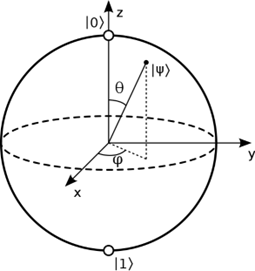One of the topics that arouses more interest in the last years in the domain of optics is quantum photonics. In this post, we will approach this discipline and explain some of its basic concepts while trying to keep it simple.
Quantum optics is the study of photons, which are the quantum (minimum amount of a magnitude) of the electromagnetic field, including electromagnetic radiation and light. Photons are a type of bosons and travel at the speed of light in vacuum (aprox. 3·109 m/s). Quantum optics covers the study of the interaction of photons with atoms and molecules, as well as the properties of photons.
Quantum photonics is the practical application of quantum optics (the theoretical basis) for the development of new technologies. Quantum photonics include the generation (single-photon emitters), manipulation and detection (photon counting) of light and matter on the quantum level.
In quantum photonics, it is important the concept of ‘qubit’ or quantum bit, which is the basic unit of quantum information. A classical bit can only be ‘0’ or ‘1’ at any specific time, whereas the general state of a qubit is a superposition of both states, which can be understood in a simple way as being both ‘0’ and ‘1’ at the same time. However, once the qubit is measured, there are only two possible outcomes, ‘0’ or ‘1’.

Another important phenomenon present in qubits is quantum entanglement, which describes the correlations that appear when quantum systems (such as photons, electrons) interact and then become separated. This implies that the quantum state of one particle can be predicted from the state of another particle with which the first one is ‘entangled’, even if both particles are separated by large distances.
These properties and phenomena are important in the applications of quantum photonics, which include the following:
- Quantum metrology: its purpose is the estimation of unknown physical parameters by employing quantum resources, improving the results obtained with classical physics. Among the different physical systems that can be used in quantum metrology, photons have interesting properties such as high mobility and low interaction with the environment.
- Quantum computing: it is based on the previously explained qubits, which are employed by quantum computers to perform certain operations at a higher speed than classical computers, although they are still not able to surpass them for practical applications. One of the current challenges in this field is building a large-scale quantum computer.

- Quantum cryptography: it consists in applying quantum mechanical properties to cryptographic tasks. One the best known examples of quantum cryptography is quantum key distribution (QKD), where quantum communication is used to establish a shared key between two parties without the possibility of its unnoticed interception by a third party. In case this happened, the quantum key distribution protocol detects the intrusion due to its own nature.
Finally, it must also be remarked the increasing importance of integrated quantum photonics. Electronics development gave a step forward with the introduction of the integrated circuit. Analogously, integrated quantum photonic circuits have allowed the generation, processing and detection of quantum states of light in millimeter scale footprints. These circuits are crucial for the development of 5G and 6G communications.
In conclusion, we have given a brief overview of quantum photonics, including its definition, some basic concepts (qubit, superposition, entanglement) and a few of its applications (quantum metrology, quantum computing and quantum cryptography) with the purpose of providing a first and comprehensive approach to this subject.
Bibliography
[1] Quantum Cryptography – RP Photonics
[2] Quantum Optics – RP Photonics
[3] Quantum computing 101: what’s superposition, entanglement and a qubit?, John Davidson
[4] Quantum computing – Wikipedia
